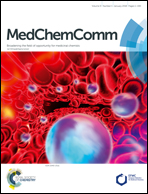Identification of non-substrate-like glycosyltransferase inhibitors from library screening: pitfalls & hits†
Abstract
Bacterial glycosyltransferases are potential targets for the development of novel antibiotics and anti-virulence agents. Most existing glycosyltransferase inhibitors are substrate analogues with limited potential for drug development. The identification of alternative inhibitor chemotypes is therefore of great interest for medicinal chemistry, drug discovery and chemical glycobiology. We describe the application of a biochemical glycosyltransferase assay to screen a small compound library containing three distinct chemical scaffolds (nucleosides, steroids and 5-methyl pyrazol-3-ones) against the retaining α-1,4-galactosyltransferase LgtC from Neisseria meningitidis. While no genuine LgtC inhibitory activity was observed in the nucleoside and steroid series, the best hit compounds in the 5-methyl pyrazol-3-one series showed low micromolar activity. We adapted our assay protocol to develop initial structure–activity relationships in this series, and to establish the target selectivity of the most potent inhibitor over two other glycosyltransferases. Our results provide insights into the activity of this class of non-substrate-like glycosyltransferase inhibitors, and highlight important general pitfalls for inhibitor screening against this enzyme family. Key elements of our experimental design, including a validated single-concentration protocol for inhibitor screening, and our process for elimination of false positives, are, in principle, directly transferable to many other sugar-nucleotide-dependent glycosyltransferases.



 Please wait while we load your content...
Please wait while we load your content...